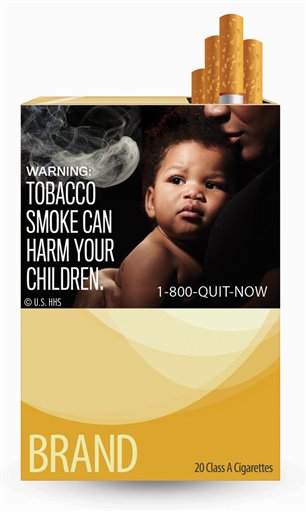RICHMOND, Va. — A judge today blocked a federal requirement that would have begun forcing U.S. tobacco companies to put large graphic images on their cigarette packages later this year to show the dangers of smoking and encouraging smokers to quit lighting up.
U.S. District Judge Richard Leon in Washington ruled that the federal mandate to put the images, which include a sewn-up corpse of a smoker and a picture of diseased lungs, on cigarette packs violate the free speech amendment to the Constitution.
He had temporarily blocked the requirement in November, saying it was likely cigarette makers will succeed in a lawsuit, which could take years to resolve. That decision already is being appealed by the government.
Some of the largest U.S. tobacco companies, including R.J. Reynolds Tobacco Co. and Lorillard Tobacco Co., had questioned the constitutionality of the labels, saying the warnings don’t simply convey facts to inform people’s decision whether to smoke but instead force the cigarette makers to display government anti-smoking advocacy more prominently than their own branding. They also say that changing cigarette packaging will cost millions of dollars.
Meanwhile, the Food and Drug Administration has said that the public interest in conveying the dangers of smoking outweighs the companies’ free speech rights.
In his ruling today, Leon wrote that the graphic images “were neither designed to protect the consumer from confusion or deception, nor to increase consumer awareness of smoking risks; rather, they were crafted to evoke a strong emotional response calculated to provoke the viewer to quit or never start smoking.”
Leon also pointed out alternatives for the federal government to curb tobacco use, such as increasing anti-smoking advertisements, raising tobacco taxes, reducing the size and changing content of the labels, and improving efforts to reduce youth access to tobacco products.
The FDA did not immediately provide a comment on today’s ruling.
The nine graphic images approved by the FDA in June include color images of a man exhaling cigarette smoke through a tracheotomy hole in his throat; a plume of cigarette smoke enveloping an infant receiving a mother’s kiss; a pair of diseased lungs next to a pair of healthy lungs; a diseased mouth afflicted with what appears to be cancerous lesions; a man breathing into an oxygen mask; a cadaver on a table with post-autopsy chest staples; a woman weeping; a premature baby in an incubator; and a man wearing a T-shirt that features a “No Smoking” symbol and the words “I Quit.”
The FDA requirement said the labels were to cover the entire top half of cigarette packs, front and back and include a number for a stop-smoking hotline. The labels were to constitute 20 percent of cigarette advertising, and marketers were to rotate use of the images.
Joining North Carolina-based R.J. Reynolds, owned by Reynolds American Inc., and Lorillard Tobacco, owned by Lorillard Inc., in the lawsuit are Commonwealth Brands Inc., Liggett Group LLC and Santa Fe Natural Tobacco Company Inc.
Richmond-based Altria Group Inc., parent company of the nation’s largest cigarette maker, Philip Morris USA, which makes top-selling Marlboros, is not a part of the lawsuit.
The free speech lawsuit is separate from a lawsuit by several of the same companies over the Family Smoking Prevention and Tobacco Control Act. That law, which took effect two years ago, cleared the way for the more graphic warning labels. But it also allowed the FDA to limit nicotine and banned tobacco companies from sponsoring athletic or social events or giving away free samples or branded merchandise.
A federal judge upheld many parts of the law, but the case is now pending before the U.S. 6th Circuit Court of Appeals in Cincinnati.
While the tobacco industry’s latest legal challenge may not hold up, it could delay the new warning labels for years. And that is likely to save cigarette makers millions of dollars in lost sales and increased packaging costs.
Tobacco companies are increasingly relying on their packaging to build brand loyalty and grab consumers. It’s one of few advertising levers left to them after the government curbed their presence in magazines, billboards and TV.
Send questions/comments to the editors.



Success. Please wait for the page to reload. If the page does not reload within 5 seconds, please refresh the page.
Enter your email and password to access comments.
Hi, to comment on stories you must . This profile is in addition to your subscription and website login.
Already have a commenting profile? .
Invalid username/password.
Please check your email to confirm and complete your registration.
Only subscribers are eligible to post comments. Please subscribe or login first for digital access. Here’s why.
Use the form below to reset your password. When you've submitted your account email, we will send an email with a reset code.